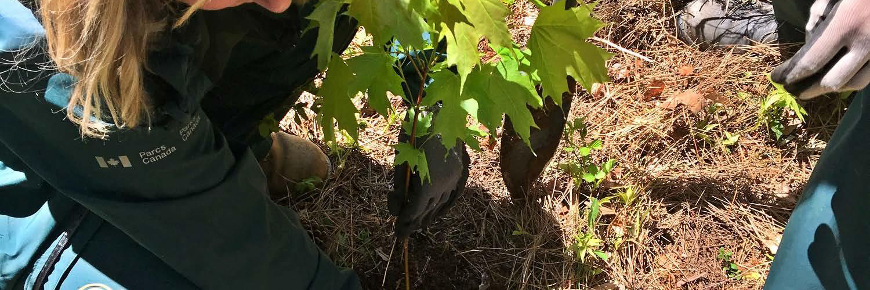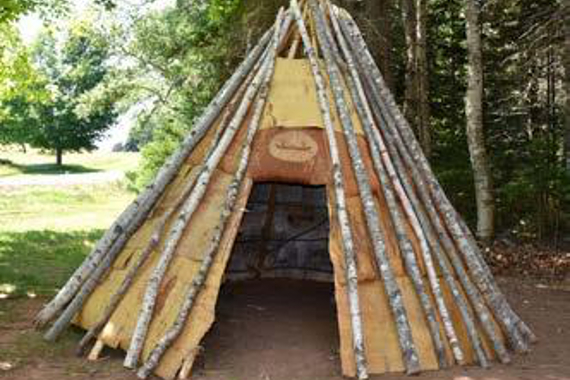
A Parks Canada summer student plants a sugar maple seedling in an effort to restore Acadian forest. Photo: © Hailey Lambe
Our future forests
Restoring the Acadian forests of PEI National Park
What’s the issue?

The Acadian forest region is made up of a unique blend of northern hardwood and boreal forest trees found nowhere else on earth. Historically extending throughout the Maritimes, including what is now Prince Edward Island National Park, healthy Acadian forest typically includes trees at various stages of maturity – from seedlings to 200-year-old matriarchs. This rich combination once offered diverse habitats for wildlife that depend on old-growth forests – species such as pileated woodpeckers, which nest in tree cavities, and various mammals like flying squirrels. For the Mi’kmaw people, Acadian forests were also an essential part of their culture. The forests provided food, medicine, materials for shelter (wigwams), transportation (canoes, snowshoes) and various utensils (baskets, fishing spears). Today, as little as 1 to 5 percent of Acadian forest remains in its natural state, much having been cleared for agriculture. In PEI National Park, most forests have begun the slow process of returning to Acadian forest, but are in early stages of succession, primarily as white spruce monocultures. The loss has reduced biodiversity, diminished ecosystem function and had negative cultural impacts for Indigenous people.
What’s our approach?
- Increase the area available to re-establish Acadian forest by removing unnecessary infrastructure (buildings, roads) from the park.
- In white spruce monocultures, speed up the process of change and transition to Acadian species by cutting patches and thinning the forest. Use low impact removal techniques that mimic natural disturbance such as wind storms and natural mortality.
- Where appropriate, plant a diversity of Acadian forest species sourced from local nurseries.
- Create a database of seed-bearing Acadian species in the park to help support seed-banking and planting of locally sourced seedlings.
- Collaborate with the Indigenous community to gain information about cultural perspectives for incorporation into the restoration plan.
What’s been accomplished?
- Removed 19 hectares of infrastructure, including roads, parking lots and buildings, creating space for the re-establishment of Acadian forest.
- Thinned 27 hectares of white spruce monoculture to accelerate regeneration of Acadian species.
- Planted more than 54,000 seedlings of Acadian tree and shrub species across 120 hectares.
- Located and documented mature, seed-bearing trees of Acadian species to track growth and seed production.
- Gained rich cultural perspectives from Mi’kmaw elders, who shared the importance of Acadian forest species such as white birch – its bark is used by Indigenous artisans and fungus has medicinal properties – which ensured their inclusion in the restoration plan.
- Date modified :